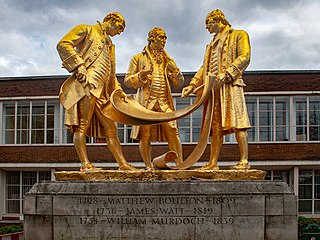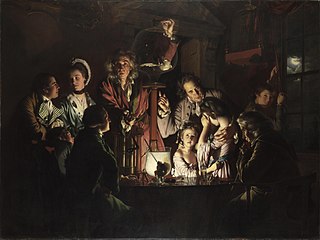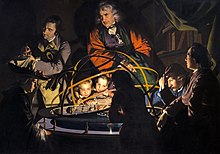
Erasmus Robert Darwin was an English physician. One of the key thinkers of the Midlands Enlightenment, he was also a natural philosopher, physiologist, slave-trade abolitionist, inventor, and poet.

The Lunar Society of Birmingham was a British dinner club and informal learned society of prominent figures in the Midlands Enlightenment, including industrialists, natural philosophers and intellectuals, who met regularly between 1765 and 1813 in Birmingham. At first called the Lunar Circle, "Lunar Society" became the formal name by 1775. The name arose because the society would meet during the full moon, as the extra light made the journey home easier and safer in the absence of street lighting. The members cheerfully referred to themselves as "lunaticks", a contemporary spelling of lunatics. Venues included Erasmus Darwin's home in Lichfield, Matthew Boulton's home, Soho House, Bowbridge House in Derbyshire, and Great Barr Hall.

Matthew Boulton was an English businessman, inventor, mechanical engineer, and silversmith. He was a business partner of the Scottish engineer James Watt. In the final quarter of the 18th century, the partnership installed hundreds of Boulton & Watt steam engines, which were a great advance on the state of the art, making possible the mechanisation of factories and mills. Boulton applied modern techniques to the minting of coins, striking millions of pieces for Britain and other countries, and supplying the Royal Mint with up-to-date equipment.

Soho House is a museum run by Birmingham Museums Trust, celebrating Matthew Boulton's life, his partnership with James Watt, his membership of the Lunar Society of Birmingham and his contribution to the Midlands Enlightenment and the Industrial Revolution. It is a Grade II* listed 18th-century house in Handsworth, part of Birmingham since 1911, but historically in the county of Staffordshire. It was the home of entrepreneur Matthew Boulton from 1766 until his death in 1809, and a regular meeting-place of the Lunar Society.

Anna Seward was an English Romantic poet, often called the Swan of Lichfield. She benefited from her father's progressive views on female education.

Joseph Wright, styled Joseph Wright of Derby, was an English landscape and portrait painter. He has been acclaimed as "the first professional painter to express the spirit of the Industrial Revolution".

Birmingham has seen 1400 years of growth, during which time it has evolved from a small 7th century Anglo Saxon hamlet on the edge of the Forest of Arden at the fringe of the early Mercia into a major city. A combination of immigration, innovation and civic pride helped to bring about major social and economic reforms and create the Industrial Revolution, inspiring the growth of similar cities across the world.

Andrew Bell (1726–1809) was a Scottish engraver and printer, who co-founded Encyclopædia Britannica with Colin Macfarquhar.

Derby Museum and Art Gallery is a museum and art gallery in Derby, England. It was established in 1879, along with Derby Central Library, in a new building designed by Richard Knill Freeman and given to Derby by Michael Thomas Bass. The collection includes a gallery displaying many paintings by Joseph Wright of Derby; there is also a large display of Royal Crown Derby and other porcelain from Derby and the surrounding area. Further displays include archaeology, natural history, geology, military collections and world cultures. The Art Gallery was opened in 1882.

Boulton & Watt was an early British engineering and manufacturing firm in the business of designing and making marine and stationary steam engines. Founded in the English West Midlands around Birmingham in 1775 as a partnership between the English manufacturer Matthew Boulton and the Scottish engineer James Watt, the firm had a major role in the Industrial Revolution and grew to be a major producer of steam engines in the 19th century.
Birmingham is one of England's principal industrial centres and has a history of industrial and scientific innovation. It was once known as 'city of a thousand trades' and in 1791, Arthur Young described Birmingham as "the first manufacturing town in the world". Right up until the mid-19th century Birmingham was regarded as the prime industrial urban town in Britain and perhaps the world, the town's rivals were more specific in their trade bases. Mills and foundries across the world were helped along by the advances in steam power and engineering that were taking place in the city. The town offered a vast array of industries and was the world's leading manufacturer of metal ware, although this was by no means the only trade flourishing in the town.

An Experiment on a Bird in the Air Pump is a 1768 oil-on-canvas painting by Joseph Wright of Derby, one of a number of candlelit scenes that Wright painted during the 1760s. The painting departed from convention of the time by depicting a scientific subject in the reverential manner formerly reserved for scenes of historical or religious significance. Wright was intimately involved in depicting the Industrial Revolution and the scientific advances of the Enlightenment. While his paintings were recognized as exceptional by his contemporaries, his provincial status and choice of subjects meant the style was never widely imitated. The picture has been owned by the National Gallery in London since 1863 and is regarded as a masterpiece of British art.

The Derby Philosophical Society was a club for gentlemen in Derby founded in 1783 by Erasmus Darwin. The club had many notable members and also offered the first institutional library in Derby that was available to some section of the public.

Jonathan Stokes was an English physician and botanist, a member of the Lunar Society of Birmingham, and an early adopter of the heart drug digitalis.
David Matthew Sandner is an author and editor of fantasy literature and a professor at California State University, Fullerton.

The literary tradition of Birmingham originally grew out of the culture of religious puritanism that developed in the town in the 16th and 17th centuries. Birmingham's location away from established centres of power, its dynamic merchant-based economy and its weak aristocracy gave it a reputation as a place where loyalty to the established power structures of church and feudal state were weak, and saw it emerge as a haven for free-thinkers and radicals, encouraging the birth of a vibrant culture of writing, printing and publishing.

Dr Samantha George is a Senior Lecturer in Literature in the Social Sciences, Arts & Humanities Research Institute at the University of Hertfordshire. She completed a PhD at the University of York in 2004, then taught in the Department of English Literature at Sheffield University till taking up her post at Hertfordshire in 2007. She is known for her research on eighteenth century literature and science with a particular emphasis on the role of women and botany.
Maria Elizabetha Jacson was an eighteenth-century English writer, as was her sister, Frances Jacson (1754–1842), known for her books on botany at a time when there were significant obstacles to women's authorship. In some sources her name appears as Maria Jackson, Mary Jackson or Mary Elizabeth Jackson. She spent most of her life in Cheshire and Derbyshire, where she lived with her sister following her father's death.
Peter M. Jones is professor of French history at the University of Birmingham. He is a specialist in the French Revolution, rural France, science and technology in the 18th century, and the history of Birmingham and the West Midlands in the 18th century.
Gregory Stephen Brown is an American historian specializing in French history and cultural History. His research regards "Enlightenment France and issues of 'self-fashioning,' performance and printing, patronage, and censorship." He is the General Editor and Senior Research Fellow at the Voltaire Foundation, University of Oxford, for the Oxford University Studies in the Enlightenment.














